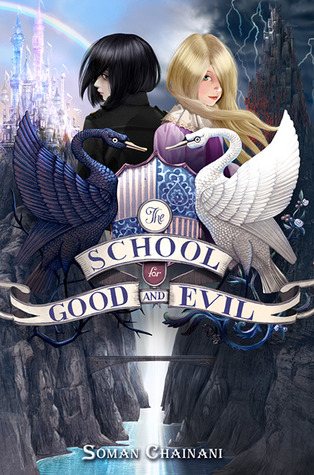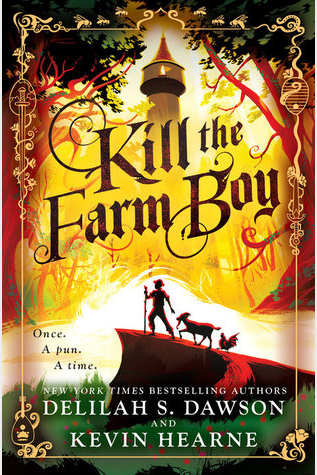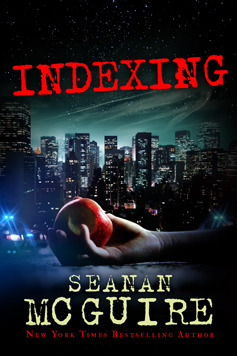I received this book for free from in exchange for an honest review. This does not affect my opinion of the book or the content of my review.

The School for Good and Evil
by
Soman Chainani
It is part of the The School for Good and Evil #1 series and is a fairytale in a hardcover edition that was published by HarperCollins on May 14, 2013 and has 488 pages.
Explore it on Goodreads or Amazon
Illustrator: Iacopo Bruno
First in the School for Good and Evil fantasy series for Middle-Grade readers.
A fantasy for children about good and evil which emphasizes friendship and incorporates the precept: don’t judge a book by its cover.
My Take
In some ways, it’s rather simplistic with the School for Evil and its Evil Shore and the vice versa of the School for Good and its Good Shore as well as being a contender as a Harry Potter wannabe — for a much younger audience. It’s a good story with a surprisingly mature vocabulary, even though the sentences and many of the conflicts are too obvious.
Be sure to check out the map just inside the front cover. It’s nicely done and gives you a sense of what — where — you’re reading.
While I understand that it’s Agatha’s goodness that makes things go right, I am surprised that she’s so amazingly dim when it comes to Sophie and her selfishness. It was so obvious that it was annoying.
Chainani wants to be sure you get that Sophie’s character is evil; it’s almost too childish with that heavy foot Chainani is stomping with — I’m surprised that Sophie can’t hear the author let alone herself. I do have to wonder if Chainani is taking the mickey out of our image-obsessed culture — Sophie is so worried that she might be developing thick thighs when everyone knows princesses always have perfect proportions!
There are some good lessons in this. And they’re obvious enough that the kids should pick up on it easily. Lessons that might help them determine if someone at school really wants to be friends. That Sophie pfft she tests her creams and potions on Agatha to see if they’ll work and claims that’s what friends do. Help each other. Yep, as long as it’s Agatha she’s practicing on and not herself! Agatha, well, she’s different. She thinks weddings are scary, publicly refuses to believe in those fairy tale stories, and being friends with Sophie makes her feel normal. The truth of love — and it’s not kisses! That ongoing issue Sophie has with not listening. Why studying is a good way to survive!
I like the Storybook theory the kids have. A very clever twist by Chainani to take this to a different level and introduce some depth.
It’s not what we are,
It’s what we do.
See if the kids can identify all the fairy tales Cainani adds into the story. With the same idea, see if the kids can tell you the stories of those students who succeeded and entered into certain fairy tales.
I was impressed by how well Cainani played on my mind. Even though I knew Sophie deserved to be in Evil, Cainani had me doubting it from time to time.
Manley’s premise that ugliness is better than beauty made sense. If you can’t get by on prettiness, you develop your mind. It was just a bit hard to swallow the way he presents it.
Sophie does get clever. I love how she forces Hester to help her entice Tedros. Her Lunchtime Lectures on beauty are a crack-up with a combination of good advice and a slap in the face for the boys.
I am looking forward to reading A World without Princes that is currently scheduled to be released in 2014. I’m dying to find out where Chainani goes from here!
The Story
Sophie just knows she’ll be taken for Good School, at least until she’s mean to that ugly Radley. Well, after all, “she’s beautiful, he’s ugly. Only a villain would delude him. Surely the School Master would understand that.”
Everyone in the village knows that the School Master will raid Gavaldon for two children: one for the School of Good and one for Evil. It’s happened every four years for the past two hundred years.
Sophie is positive that she’ll be taken, she’s praying for it, hoping for it, knowing that she’s destined for Good, and if the School Master should take Agatha, well, it would be perfect since she’s so obviously for Evil. I mean, look at them!
Only it goes wrong for both Sophie and Agatha.
The Characters
Sophie is beautiful and very concerned with being kidnapped the next time the School Master raids her village. She’s working very hard at being kind. Including calling Agatha her best friend. Stefan, a millworker, is her hardworking, widowed father. He’s interested in the widow Honora, who has two sons. Grimm is a mean, nasty, ugly cherub.
Agatha is another ugly one whom everyone thinks is a witch, and she lives at the top of the hill in the village graveyard. Reaper is her bald, wrinkled cat. Callis is her scary mother, who’s anticipating Agatha getting into the School of Evil.
Students of the School of Good, the Evers
Beatrix is the belle of this class, and she knows it. Kiko is about the only Good girl, besides Agatha, who gets the truth of Good. Reena, Ava, Giselle, and Millicent are other Goods. Tedros is the son of King Arthur and carries his sword, Excalibur. He leads the boy princes at the school who include Tristan, Chaddick, and Nicholas.
Students of the School of Evil, the Nevers
Dot, whose talent is turning anything she touches into chocolate; the wicked, demon-carrying Hester; and, Anadil, who can control rats and make them grow, are Sophie’s roommates. Mona has green skin and can make her lips glow red, and Arachne can pop out an eye. Beezle, Vex, Brone, Hort grows hair, Ravan, Flynt, and Titan are boys.
Garrick and Bane, a little boy who liked to bite the girls, were kidnapped from Gavaldon.
The teachers are good and evil, instructing in both schools
Professor Sheeba Sheeks teaches Special Talents; Professor Bilious Manley teaches Uglification; Castor (he’s a two-headed dog — Pollux is the other half — with a split personality and a removable head); Lady Lesso teaches Curses and Death Traps; Yuba the Gnome takes the children into the Blue Forest to teach Surviving Fairy Tales; Professor Clarissa Dovey is the dean of Good; Professor Sader is a seer; Princess Uma teaches Animal Communication; the very weird Professor Anemone who teaches Beauty Secrets; and, Professor Espada.
The School Master is the kidnapper for the School of Good and Evil. He protects the balance of good and evil. The Storian is a pen that writes the fairy tales, the stories that pull Good and Evil in to be the characters of their books. The Beast is a huge black wolf who tortures the children in the Doom Room. The Crypt Keeper is quite particular about how the dead are buried.
Mr. Deaville owns the Storybook Shop at which the original storybooks appear. Every four years.
Readers are children from Gavaldon. Evers are Good and Nevers are Bad. Students eventually will graduate to one of three levels: Leaders “train to fight their future Nemeses”; Followers become henchmen or helpers; and Mogrifs are the ones who change.
The Cover and Title
The cover is cute with the girls hovering over the moat that separates the schools. The rainbow-kissed school of pastels with the black-clad, slightly Gothic Agatha and the black swan facing off with the white swan in front of the pink and gleaming Sophie side by side with the lightning-struck school of black.
The title sums it all up with the girls perfectly positioned for the divided school they attend, The School of Good and Evil.











[…] Book Review: Soman Chainani’s School for Good and Evil (kddidit.wordpress.com) […]